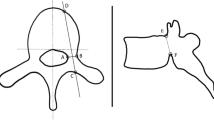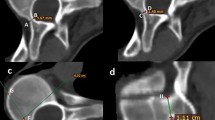Abstract
Background: The key to the safe and effective use of thoracic pedicle screws in the deformed spine is to thoroughly understand pedicle anatomy. There are a few studies related to pedicle anatomy in the Indian population and no pedicle morphometric studies in scoliosis patients. The present study aims to highlight the differential features of pedicle morphometry, including pedicle width, transverse pedicle angle and the depth to anterior cortex on the concave and convex side, in a group of Indian patients with adolescent idiopathic scoliosis and compare this to that of a western population.
Materials and Methods: This is a prospective study of 24 patients with adolescent idiopathic scoliosis. The average age is 14.6 years (12.3–18.3 years) of which 14 were females and 10 were males. All the patients underwent CT scan using Siemens 4th generation scanner. The scans were analyzed by measuring the transverse pedicle width, transverse pedicle angle and the chord length; all the measurements being made both on the convex as well as the concave pedicle. Statistical analysis was performed with unpaired ‘t’ test.
Results: A total of 1295 measurements were performed from 24 patients and an average of 215 pedicles were assessed for each set of the measurements made. The transverse pedicle width was consistently found to be smaller on concave side in comparison with the convex side at all levels except at T1. The transverse pedicle angle was greater on the concave side at all levels as compared to the convex side, though there was wide individual variation. The depth to anterior cortex was lesser on convex side in comparison to the concave side except at T1.
Conclusions: The concave pedicle is much thinner and directed more medially than the convex side, especially at the apical region of the scoliotic curve. The pedicle anatomy in scoliosis patients shows very high individual variations and a careful study of pre-operative CT scans is essential for planning proper pedicle screw placement. Slightly longer screws can be accommodated on the concave side as compared to the convex side, though the difference in the chord length is not statistically significant at most levels.
Similar content being viewed by others
References
Zindrick MR, Wiltse LL, Doornik A, Widell EH, Knight GW, Patwardhan AG, et al.. Analysis of the morphometric characteristics of the thoracic and lumbar pedicles. Spine 1987;12:160–6.
Cheung KM, Ruan D, Chan FL, Fang D. Computed tomographic osteometry of Asian lumbar pedicles. Spine 1994;19:1495–8.
Chadha M, Balain B, Maini L, Dhaon BK. Pedicle morphology of the lower thoracic, lumbar, and S1 vertebrae: An Indian perspective. Spine 2003;28:744–9.
Hou S, Hu R, Shi Y. Pedicle morphology of the lower thoracic and lumbar spine in a Chinese population. Spine 1993;18:1850–5.
Kim N, Lee H, Chung I, Kim H, Kim S. Morphometric study of the pedicles of thoracic and lumbar vertebrae in Koreans. Spine 1994;19:1390–4.
Datir SP, Mitra SR. Morphometric study of the thoracic vertebral pedicle in an Indian population. Spine 2004;29:1174–81.
Mitra SR, Datir SP, Jadhav SO. Morphometric study of the lumbar pedicle in the Indian population as related to pedicular screw fixation. Spine 2002;27:453–9.
Krag MH, Weaver DL, Beynnon BD, Haugh LD. Morphometry of the thoracic and lumbar spine related to transpedicular screw placement for surgical spinal fixation. Spine 1988;13:27–32.
Ugur HC, Attar A, Uz A, Tekdemir I, Egemen N, Genc Y. Thoracic pedicle: Surgical anatomic evaluation and relations. J Spinal Disord 2001;14:39–45.
Chaynes P, Sol JC, Vaysse P, Becue J, Lagarrigue J. Vertebral pedicle anatomy in relation to pedicle screw fixation: A cadaver study. Surg Radiol Anat 2001;23:85–90.
Zindrick MR, Knight GW, Sartori MJ, Carnevale TJ, Patwardhan AG, Lorenz MA. Pedicle morphology of the immature thoracolumbar spine. Spine 2000;25:2726–35.
Nojiri K, Matsumoto M, Chiba K, Toyama Y. Morphometric analysis of the thoracic and lumbar spine in Japanese on the use of pedicle screws. Surg Radiol Anat 2005;27:123–8.
Gallagher JC, Hedlund LR, Stoner S, Meeger C. Vertebral morphometry: Normative data. Bone Miner 1988;4:189–96.
O’Brien MF, Lenke LG, Mardjetko S, Lowe TG, Kong Y, Eck K, et al.. Pedicle morphology in thoracic adolescent idiopathic scoliosis: Is pedicle fixation an anatomically viable technique? Spine 2000;25:2285–93.
Belmont PJ Jr, Klemme WR, Dhawan A, Polly DW Jr. In vivo accuracy of thoracic pedicle screws. Spine 2001;26:2340–6.
Belmont PJ Jr, Klemme WR, Robinson M, Polly DW Jr. Accuracy of thoracic pedicle screws in patients with and without coronal plane spinal deformities. Spine 2002;27:1558–66.
Xiong B, Sevastik B, Sevastik J, Hedlund R, Suliman I, Kristjansson S. Horizontal plane morphometry of normal and scoliotic vertebrae. Eur Spine J 1995;4:6–10.
Cinnoti G, Gumina S, Ripnai M, Postacchini F. Pedicle instrumentation in the thoracic spine. A morphometric and cadaveric study for placement of screws. Spine 1999;24:114–9.
Liljenqvist UR, Link TM, Halm HF. Morphometric analysis of thoracic and lumbar vertebrae in idiopathic scoliosis. Spine 2000;25:1247–53.
Takeshita K, Maruyama T, Chikuda H, Shoda N, Seichi A, Ono T, et al.. Diameter, length, and direction of pedicle screws for scoliotic spine: Analysis by multiplanar reconstruction of computed tomography. Spine 2009;34:798–803
Misenheimer GR, Peek RD, Wiltse LL, Rothman SL, Widell EH Jr. Anatomic analysis of pedicle cortical and cancellous diameter as related to screw size. Spine 1989;14:367–72.
Suk S, Lee JH. A study of the diameter and change of the vertebral pedicle after screw insertion. Presented at the 3rd Intermeeting SIROT, Boston, Massachusetts. October 1994.
Kotwicki T, Napiontek M. Intravertebral deformation in idiopathic scoliosis: A transverse plane computer tomographic study. J Pediatr Orthop 2008;28:225–9.
Author information
Authors and Affiliations
Corresponding author
Rights and permissions
About this article
Cite this article
Upendra, B., Meena, D., Kandwal, P. et al. Pedicle morphometry in patients with adolescent idiopathic scoliosis. IJOO 44, 169–176 (2010). https://doi.org/10.4103/0019-5413.62084
Published:
Issue Date:
DOI: https://doi.org/10.4103/0019-5413.62084




